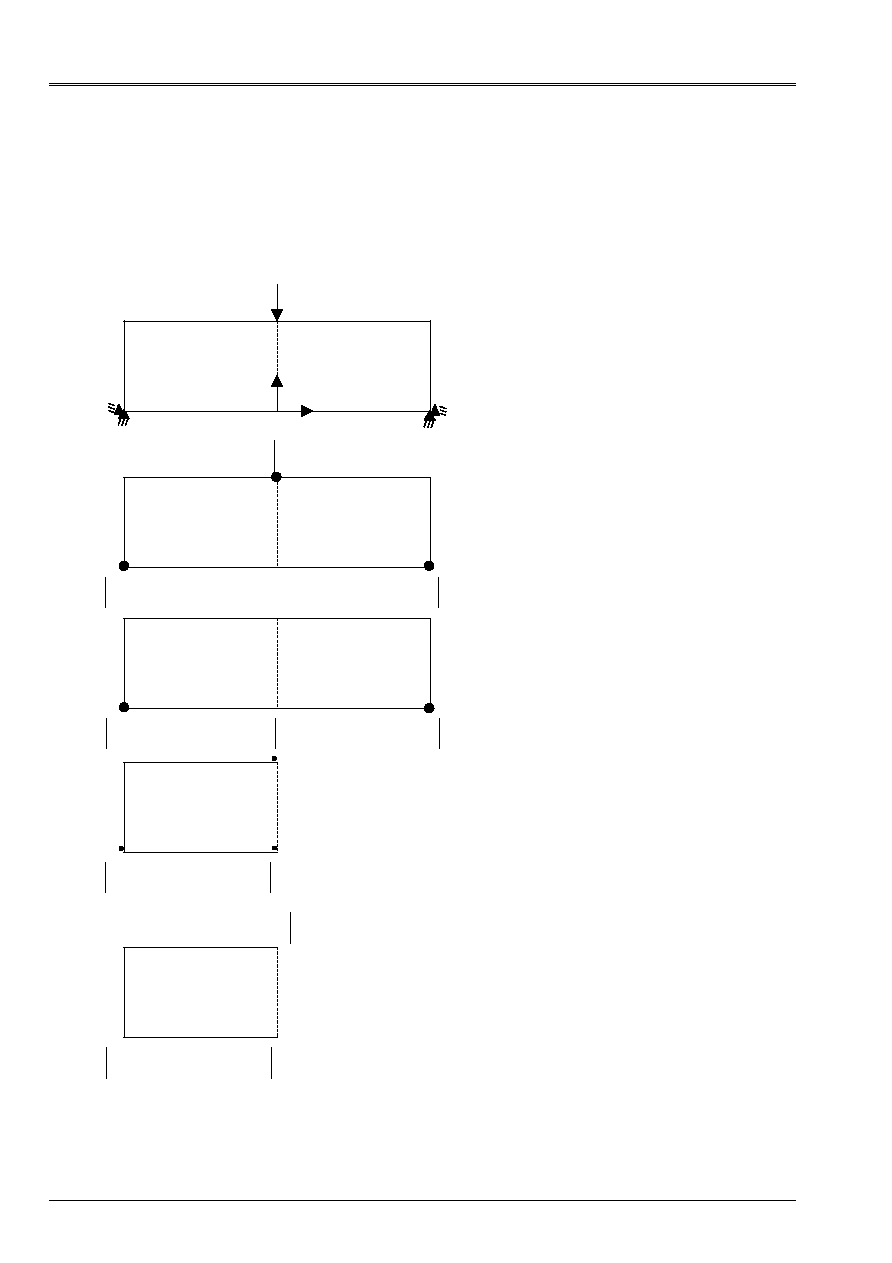
Code_Aster
®
Version
8.2
Titrate:
Operator
CALC_NO
Date:
22/02/06
Author (S):
X. DESROCHES
Key
:
U4.81.02-H1
Page:
1/12
Instruction manual
U4.8- booklet: Postprocessing and dedicated analyzes
HT-62/06/004/A
Organization (S):
EDF-R & D/AMA
Instruction manual
U4.8- booklet: Postprocessing and dedicated analyzes
Document: U4.81.02
Operator
CALC_NO
1 Goal
To enrich a structure of data result by options of postprocessing. It acts in particular
options nodal forces, reactions of support and more generally all options of sizes
elementary with the nodes (options xxxx_NOEU_xxxx) transforming a cham_elem with the nodes into one
chamno.
The concept result is réentrant.

Code_Aster
®
Version
8.2
Titrate:
Operator
CALC_NO
Date:
22/02/06
Author (S):
X. DESROCHES
Key
:
U4.81.02-H1
Page:
2/12
Instruction manual
U4.8- booklet: Postprocessing and dedicated analyzes
HT-62/06/004/A
2 Syntax
resu [*]
=
CALC_NO
(
reuse=
resu,
RESULT
=
resu,
/[evol_elas]
/
[mode_stat_depl]
/[evol_noli]
/
[mode_stat_acce]
/[evol_ther]
/
[mode_stat_forc]
/[mult_elas]
/
[mode_stat]
/[fourier_elas]
/
[mode_acou]
/[mode_flamb]
/
[dyna_trans]
/[base_modale]
/
[dyna_harmo]
/[mode_meca]
/
[acou_harmo]
SENSITIVITY = (… to see [U4.50.02])
/
TOUT_ORDRE =
“YES”
,
[DEFECT]
/
NUME_ORDRE =
l_nuor
,
[l_I]
/
LIST_ORDRE =
l_ordr
,
[listis]
/
NOEUD_CMP
=
l_mode
,
[l_Kn]
/
NUME_MODE
=
l_numo
,
[l_I]
/
NOM_CAS =
nomcas
,
[KN]
/
/
INST
=
l_inst
,
[l_R]
/
LIST_INST
=
l_inst
,
[listr8]
/
FREQ
=
l_freq
,
[l_R]
/
LIST_FREQ
=
l_freq
,
[listr8]
I
PRECISION
=
/
prec,
[R]
/
1.0D-3
,
[DEFECT]
I
CRITERION =/“RELATIVE”
, [DEFECT]
/
“ABSOLUTE”
,
/ALL
= “YES”,
/
NET
=
lma
,
[l_maille]
/
GROUP_MA
=
lgma,
[l_gr_maille]
/NOEUD_RESU
=
lno
,
[l_noeud]
/
GROUP_NO_RESU
=
lgno,
[l_gr_noeud]
/
MAILLE_RESU
= lma,
[l_maille]
/
GROUP_MA_RESU
=
lgma,
[l_gr_maille]
OPTION
=
|
|
“FORC_NODA”
,
|
“REAC_NODA”
,
MODEL
=
model
,
[model]
CHAM_MATER = chmater, [cham_mater]
CARA_ELEM
= carac, [cara_elem]
EXCIT
=_F
(
CHARGE = load,/[char_meca]
/
[char_ther]
/
[char_acou]
FONC_MULT = coeff,
[function/formula]
TYPE_CHARGE=
/
“FIXE_CSTE”
[DEFECT]
/
“FIXE_PILO”
/
“SUIV”
),

Code_Aster
®
Version
8.2
Titrate:
Operator
CALC_NO
Date:
22/02/06
Author (S):
X. DESROCHES
Key
:
U4.81.02-H1
Page:
3/12
Instruction manual
U4.8- booklet: Postprocessing and dedicated analyzes
HT-62/06/004/A
|
|
“EFGE_NOEU_DEPL”
,
|
“EFGE_NOEU_CART”
,
|
“EPSI_NOEU_DEPL”
,
|
“SIGM_NOEU_DEPL”
,
|
“SIGM_NOEU_CART”
,
|
“SIPO_NOEU_DEPL”
,
|
“EQUI_NOEU_SIGM”
,
|
“EQUI_NOEU_EPSI”
,
|
“EQUI_NOEU_EPME”
,
|
“FLUX_NOEU_TEMP”
,
|
“SIEF_NOEU_ELGA”
,
|
“VARI_NOEU_ELGA”
,
|
“PRES_NOEU_DBEL”
,
|
“PRES_NOEU_REEL”
,
|
“PRES_NOEU_IMAG”
,
|
“INTE_NOEU_ACTI”
,
|
“INTE_NOEU_REAC”
,
|
“META_NOEU_TEMP”
,
|
“DCHA_NOEU_SIGM”
,
|
“RADI_NOEU_SIGM”
,
|
“ENDO_NOEU_SINO”
,
|
“ERRE_NOEU_ELGA”
,
|
“DEGE_NOEU_DEPL”
,
|
“SIRE_NOEU_DEPL”
,
|
“EPSG_NOEU_DEPL”
,
|
“DURT_NOEU_META”
,
|
“DETE_NOEU_DLTE”
,
|
“ENEL_NOEU_ELGA”
,
|
“SIGM_NOEU_ZAC”,
|
“EPSP_NOEU_ZAC”,
|
“PMPB_NOEU_SIEF”
,
|
“EPMG_NOEU_DEPL”
,
|
“DEDE_NOEU_DLDE”
,
|
“DESI_NOEU_DLSI”
,
|
“EPSP_NOEU”
,
|
“EPSA_NOEU”
,
|
“HYDR_NOEU_ELGA”
,
|
“SIGM_NOEU_COQU”
,
|
“SIGM_NOEU_SIEF”
,
|
“SIPO_NOEU_SIEF”
,
|
“VARI_NOEU”
,
|
“SIEF_NOEU”
,
|
“EXTR_NOEU_VARI”
,
|
“EXTR_ELNO_VARI”
,
)
If
RESULT = [typeres]
then
[*]
- >
[typeres]

Code_Aster
®
Version
8.2
Titrate:
Operator
CALC_NO
Date:
22/02/06
Author (S):
X. DESROCHES
Key
:
U4.81.02-H1
Page:
4/12
Instruction manual
U4.8- booklet: Postprocessing and dedicated analyzes
HT-62/06/004/A
3 Operands
3.1 Operand
RESULT
RESULT =
resu
Name of the result enriched in the control.
3.2 Operand
SENSITIVITY
SENSIBILITE= (….)
This key word is followed of a sensitive parameter list. It specifies that one is not interested in
result in itself but with derived from the result compared to a parameter. Thus a sequence
this type:
RESULT = resu, SENSITIVITY = (PS), OPTION = (“SIEF_NOEU_ELGA”)
mean that one wants to calculate with the nodes the derivative of the stresses compared to the parameter PS.
See [U4.50.02] for the details on the parameters associated with the key word.
3.3 Operands
TOUT_ORDRE
/
NUME_ORDRE
/
LIST_ORDRE
/
NUME_MODE
/
NOEUD_CMP
/
NOM_CAS
/
INST
/
LIST_INST
/
FREQ
/
LIST_FREQ
/
PRECISION
/
CRITERION
See [U4.71.00] for the description of these operands.
3.4 Operands
ALL/GROUP_MA/MESH
ALL = “YES”,
The options are calculated on all the mesh.
GROUP_MA = lgma,
The options are calculated on the groups of meshs contained in the list lgma.
NET = lma,
The options are calculated on the meshs contained in the list lma.
3.5 Operands
GROUP_NO_RESU/NOEUD_RESU/GROUP_MA_RESU/
MAILLE_RESU
These key words make it possible to specify the nodes where the results are wanted.
GROUP_NO_RESU = lgno,
The results are stored on the groups of nodes contained in the list lgno.
NOEUD_RESU = lno,
The results are stored on the nodes contained in the list lno.
GROUP_MA_RESU = lgma,
The results are stored on the groups of meshs contained in the list lgma.
MAILLE_RESU = lma,
The results are stored on the meshs contained in the list lma.

Code_Aster
®
Version
8.2
Titrate:
Operator
CALC_NO
Date:
22/02/06
Author (S):
X. DESROCHES
Key
:
U4.81.02-H1
Page:
5/12
Instruction manual
U4.8- booklet: Postprocessing and dedicated analyzes
HT-62/06/004/A
3.6 Operand
OPTION: “FORC_NODA”/“REAC_NODA”
OPTION = ' FORC_NODA'
Option of calculation of the nodal forces starting from the stresses at the points of GAUSS.
Calculation is done in the following way:
()
()
=
=
K K
K K
K
K
K
K
dK
Drunk
dK
U
D
U
=
=
K
K
K
T
K
K
K
K
K
dK
B
F
U
F
U
K
with
E
to élémentair
T
déplacemen
element
of
Gauss
of
points
with
S
stress
with
:
:
where
B
is the matrix connecting the deformations of the 1
er
command with displacements.
See also the document [U2.01.05].
For the elements of beam, the stresses at the points of GAUSS are in fact the nodal efforts
in the reference mark of the element (obtained by the product of the matrix of rigidity of the element by
displacement and by taking account of the efforts of thermal origin and the efforts distributed). Calculation
nodal forces is done by projecting the nodal efforts contained in the field of name
symbolic system
“SIEF_ELGA_DEPL”
in the total reference mark. Summation above on
elements applies then.
For the axisymmetric elements, integration in theta is done on a sector of 1 radian. If one
the integral of the surface effort on all the disc he wants is thus necessary to multiply by 2 pi.
The presence of the field of reference symbol '
SIEF_ELGA_DEPL
“or”
SIEF_ELGA
'is obligatory
in the concept result
resu
. One also recovers the name of the model subjacent with it
field.
OPTION = ' REAC_NODA'
Option of calculation of the nodal forces of reactions to the nodes, the stresses at the points
of GAUSS.
For the concepts result of the type
evol_elas
,
mult_elas
,
fourier_elas
or
evol_noli
, it
calculation is done by the formula:
()
()
-
U
L
D
U
with
()
+
+
=
I
I
F
D
U
F
D
U
F
U
L
.
.
I
F
F
F
I
node
with
S
specific
forces
S
surface
forces
voluminal
forces
are
where
If one notes
K
R
the vector of the nodal reactions on the element
K
, one a:
-
-
-
=
K
K
I
I
K
K
K
F
K
F
fdK
F
R
in other words one cuts off with the nodal forces the external forces applied to the element
K
.
It should be noted that the change temperature does not appear in the external forces.

Code_Aster
®
Version
8.2
Titrate:
Operator
CALC_NO
Date:
22/02/06
Author (S):
X. DESROCHES
Key
:
U4.81.02-H1
Page:
6/12
Instruction manual
U4.8- booklet: Postprocessing and dedicated analyzes
HT-62/06/004/A
For the concepts result of the mode_meca type, the formula is:
()
-
Driven
D
U
2
T
déplacemen
of
field
clean
pulsation
mass
of
stamp
is
where
U
M
See also the document [U2.01.05] and the examples [§3.4.6].
Note:
If key word GROUP_MA is indicated, options “FORC_NODA” and “REAC_NODA” are
calculated as follows:
K
F
is calculated only on the elements requested then assembled. The result is
different from a total calculation on all the field then reduced to the elements requested.
established method makes it possible to measure the reaction of a piece of model on another (see
examples [§3.4.6]).
3.6.1 Operand
MODEL
MODEL = Mo,
Name of the model on which the options are calculated.
3.6.2 Operand
CHAM_MATER
CHAM_MATER = chmater,
Name of the material field where the material characteristics of the elements are defined. This
argument is necessary for the calculation of the reactions (option '
REAC_NODA
'), which requires calculation
precondition of the elementary vector of the loadings.
3.6.3 Operand
CARA_ELEM
CARA_ELEM = carac,
The concept of the elementary characteristics of type
cara_elem
is necessary for calculation
nodal forces or reactions, if there exists in the model of the elements of structure.
3.6.4 Operand
EXCIT
EXCIT = _F
For the calculation of REAC_NODA only:
Key word factor allowing to define the various loadings which made it possible to calculate it
stress field at the points of GAUSS.
One defines a concept of the type
charge
by occurrence of the key word
EXCIT
.
3.6.4.1 Operand
CHARGE
CHARGE =
charge,
Name of a concept of the type
charge
, for the calculation of the associated elementary vector.
Necessary for the calculation of the nodal reactions.
3.6.4.2 Operand
FONC_MULT
FONC_MULT = coeff,
Name of a concept of the type
function
providing the value of the multiplying factor of
charge.

Code_Aster
®
Version
8.2
Titrate:
Operator
CALC_NO
Date:
22/02/06
Author (S):
X. DESROCHES
Key
:
U4.81.02-H1
Page:
7/12
Instruction manual
U4.8- booklet: Postprocessing and dedicated analyzes
HT-62/06/004/A
3.6.4.3 Operand
TYPE_CHARGE
TYPE_CHARGE
=
/
“FIXE_CSTE”,
load fixes (defect)
/
“FIXE_PILO”,
charge controlled (stored real amplitude
in the SD
evol_noli
)
/
“SUIV”,
following load
If the result comes from a nonlinear calculation with piloting, it is necessary for
to calculate the option
REAC_NODA
, to indicate under
EXCIT
at the same time fixed loads of type
(
“FIXE_CSTE”
) and them controlled loads of type (
“FIXE_PILO”
). Indeed, the amplitude
of these last is a parameter of the SD
evol_noli
and will be recovered by the code
in order to rebuild the true loading:
()
L v
L
L
fixed
pilo
=
+
(cf document [R5.03.01] of the operator
STAT_NON_LINE
).
To avoid putting questions, one suggests recopying in
CALC_NO
the block
EXCIT
having been used for nonlinear calculation having produced the result: thus one is
sure not to forget loads.
3.6.5 Operands
ALL/GROUP_MA/MESH
ALL = “YES”,
The options are calculated on all the mesh.
GROUP_MA = lgma,
The options are calculated on the groups of meshs contained in the list lgma.
NET = lma,
The options are calculated on the meshs contained in the list lma.
Note:
If key word GROUP_MA is indicated, options “FORC_NODA” and “REAC_NODA”
are calculated as follows:
K
F
is calculated only on the elements requested then assembled. The result
is different from a total calculation on all the field then reduced to the elements
asked. The established method makes it possible to measure the reaction of a piece of
model on another (see examples [§3.4.6]).

Code_Aster
®
Version
8.2
Titrate:
Operator
CALC_NO
Date:
22/02/06
Author (S):
X. DESROCHES
Key
:
U4.81.02-H1
Page:
8/12
Instruction manual
U4.8- booklet: Postprocessing and dedicated analyzes
HT-62/06/004/A
3.7 Examples
3.7.1 Example 1: Structure charged with nodal force F (2 elements QUAD4)
M1
M2
F
= - 1000 NR
y
X
01000
-
F
FORC_NODA
1
2
.
384
500
-
F
2
.
384
500
F
REAC_NODA
2
2
.
384
500
-
R
2
.
384
500
R
500
500
-
-
F
FORC_NODA on M1 mesh
3
2
.
384
500
F
8
.
115
.
0
F
M1
REAC_NODA on M1 mesh
4
2
.
384
500
R
8
.
115
.
0
R
M1
500
500
-
R

Code_Aster
®
Version
8.2
Titrate:
Operator
CALC_NO
Date:
22/02/06
Author (S):
X. DESROCHES
Key
:
U4.81.02-H1
Page:
9/12
Instruction manual
U4.8- booklet: Postprocessing and dedicated analyzes
HT-62/06/004/A
On this example, reactions to the nodes
2
are quite equal to the nodal forces
1
less it
loading. They represent the reactions to the supports of the structure.
If one restricts calculation with the mesh M1, the forces
3
with the nodes belonging to the border between M1 and
M2 are different. They represent the reaction of the formed model of M1 to the formed model of m2. With
to note that the nodal loading is divided by 2 bus the 2 meshs contribute to it. Nodal reactions
4
are still equal to the nodal forces minus the loading.
On the calculation restricted with the mesh m2, the nodal forces
5
according to OX are of sign contrary to calculation
restricted with the M1 mesh, illustrating the principle of the action and the reaction.
3.7.2 Example 2: Structure with loading temperature
500
500
-
F
2
.
384
500
-
F
FORC_NODA on mesh m2
5
M2
8
.
115
.
0
-
F
500
500
R
2
.
384
500
-
R
REAC_NODA on mesh m2
6
M2
8
.
115
.
0
-
R
T = 0°
M1
T = 100°
M2
T = 0°
M3
F
y
- F
1x
F
1x
F
y
- F
y
y
X
- F
y
F
1x
- F
1x
- F
y
F
y
- F
2x
- F
2x
- F
y
F
2x
F
2x
F
y
M2
FORC_NODA = REAC_NODA
FORC_NODA restricted with m2

Code_Aster
®
Version
8.2
Titrate:
Operator
CALC_NO
Date:
22/02/06
Author (S):
X. DESROCHES
Key
:
U4.81.02-H1
Page:
10/12
Instruction manual
U4.8- booklet: Postprocessing and dedicated analyzes
HT-62/06/004/A
NR
F
NR
F
NR
F
AP
E
X
X
y
3
2
3
1
4
6
9
10
2
.
1
10
8
.
7
10
4
.
3
10
.
1
3
.
0
10
.
1
-
=
=
-
=
=
=
=
-
:
Results
:
Data
On this example, the nodal forces and the nodal reactions coincide because the only loading is one
loading temperature.
If one restricts calculation with the mesh m2, the forces according to OY remain the same ones but are different
according to OX.
3.8 Operand
OPTION
Options of calculation transforming a field by element with the nodes into a field with the nodes, in
making a simple arithmetic mean (not balanced by the size of the meshs) of the values
met on the elements in a given node. These fields by elements with the nodes must have
summer calculated before and thus to appear in the resu object.
The controls calculating and documenting these fields are:
CALC_ELEM [U4.81.01] for the fields relating to the options:
“DCHA_NOEU_SIGM”
“DEGE_NOEU_DEPL”
“DEDE_NOEU_DLDE”
“DETE_NOEU_DLTE”
“DESI_NOEU_DLSI”
“DURT_NOEU_META”
“EFGE_NOEU_CART”
“EFGE_NOEU_DEPL”
“HYDR_NOEU_ELGA”
“INTE_NOEU_ACTI”
“INTE_NOEU_REAC”
“PMPB_NOEU_SIEF”
“PRES_NOEU_DBEL”
“PRES_NOEU_REEL”
“PRES_NOEU_IMAG”
“RADI_NOEU_SIGM”
“ENEL_NOEU_ELGA”
“ENDO_NOEU_SINO”
“EPMG_NOEU_DEPL”
“EPSI_NOEU_DEPL”
“EPSG_NOEU_DEPL”
“EPSA_NOEU”
“EPSP_NOEU”
“EQUI_NOEU_EPSI”
“EQUI_NOEU_EPME”
“EQUI_NOEU_SIGM”
“ERRE_NOEU_ELGA”
“FLUX_NOEU_TEMP”
“SIGM_NOEU_CART”
“SIGM_NOEU_COQU”
“SIGM_NOEU_DEPL”
“SIGM_NOEU_SIEF”
“SIPO_NOEU_DEPL”
“SIPO_NOEU_SIEF”
“SIRE_NOEU_DEPL”
“EXTR_NOEU_VARI”
STAT_NON_LINE [U4.51.03] for the fields relating to the options:
“VARI_NOEU” “VARI_NOEU_ELGA”
“SIEF_NOEU” “SIEF_NOEU_ELGA”
POST_ZAC [U4.83.21] for the fields:
“EPSP_NOEU_ZAC”
“SIGM_NOEU_ZAC”
CALC_META [U4.85.01] for the field:
“META_NOEU_TEMP”

Code_Aster
®
Version
8.2
Titrate:
Operator
CALC_NO
Date:
22/02/06
Author (S):
X. DESROCHES
Key
:
U4.81.02-H1
Page:
11/12
Instruction manual
U4.8- booklet: Postprocessing and dedicated analyzes
HT-62/06/004/A
Notice 1:
The moyennations with the nodes of computed fields in local reference marks are licit only if
the angles between these reference marks are weak. In the contrary case, they do not have a direction.
Notice 2:
Key word GROUP_MA and MESH also apply to the calculation of these options. In it
case, the arithmetic mean is made on the required meshs. There still, local calculation is
different from total calculation.
Example: by taking again example 1 of [§3.4.6], the shear stress
xy
is worth:
In total calculation,
xy
is null on M1
M2 like average of 2 opposite values. These
values are far from being null, as calculation shows it on M1 alone. Values on the border
required field are thus to interpret with precaution.
- 410.
- 410.
M1
M2
0.
0.
410.
410.
Total calculation
- 410.
- 410.
M1
- 590.
- 590.
Calculation on M1

Code_Aster
®
Version
8.2
Titrate:
Operator
CALC_NO
Date:
22/02/06
Author (S):
X. DESROCHES
Key
:
U4.81.02-H1
Page:
12/12
Instruction manual
U4.8- booklet: Postprocessing and dedicated analyzes
HT-62/06/004/A
4 Elements
concerned
For each modeling, the list of the calculable options by CALC_NO is provided in
documents [U3.11.XX] with [U3.33.XX] in the paragraph postprocessing of calculation.












